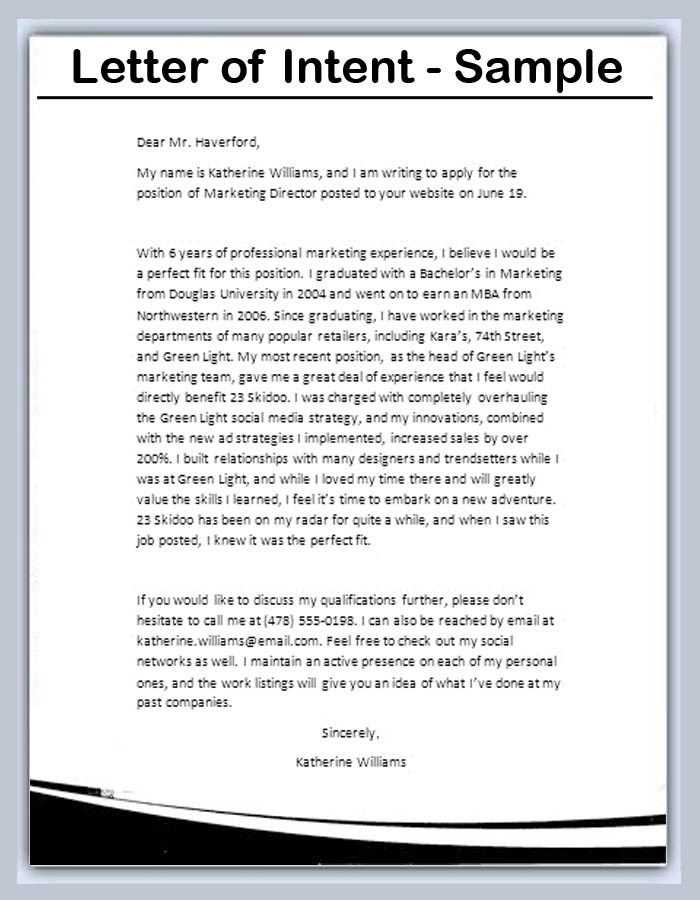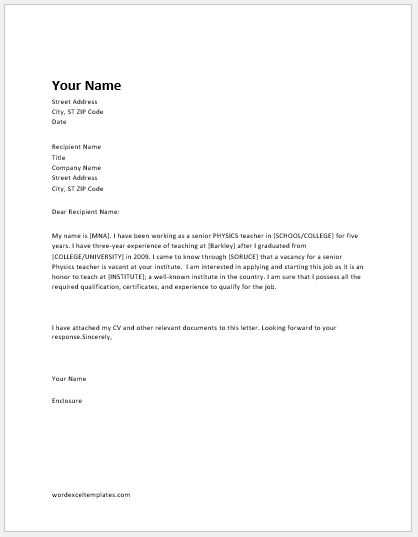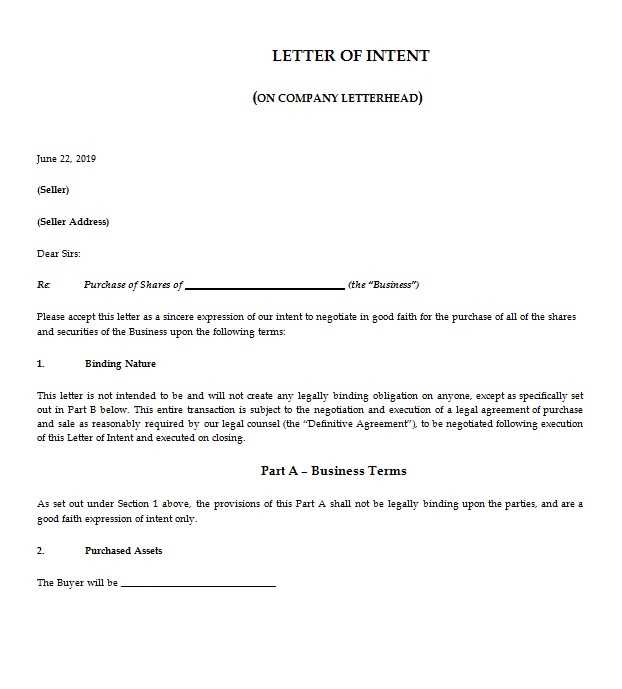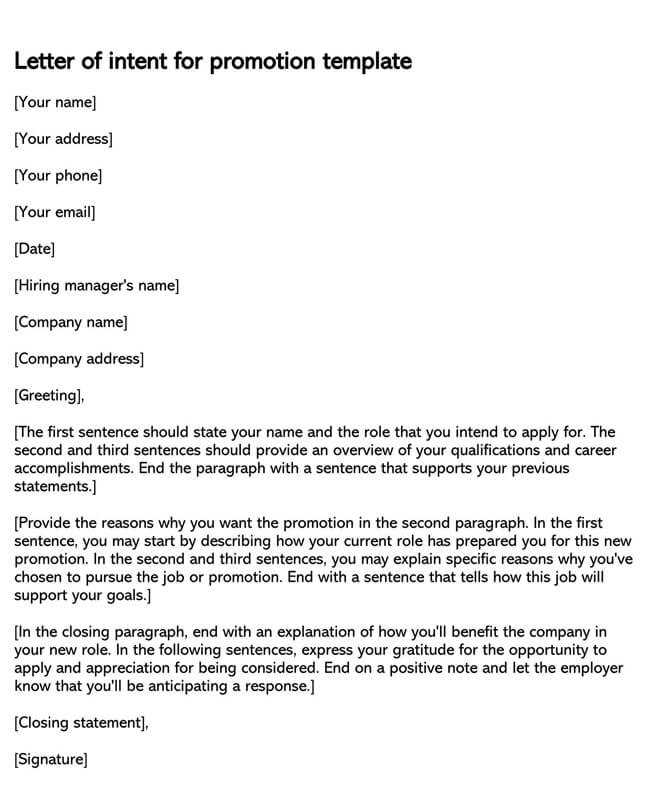Letter of intent for teaching job template

Begin your letter with a strong declaration of your interest in the teaching position. Clearly state the role you’re applying for and express your enthusiasm for the opportunity to contribute to the institution. A concise introduction that highlights your qualifications sets a positive tone for the rest of your letter.
Structure your letter logically. Start by detailing your relevant experience and skills. Mention specific teaching methods, tools, or programs you are proficient in, aligning them with the school’s goals. This helps show how your background directly supports the institution’s needs.
Conclude with a call to action. Invite the reader to contact you for further discussions and express your excitement about the possibility of joining the team. A clear and confident closing leaves a lasting impression.
Letter of Intent for Teaching Job Template

Begin with a clear statement of interest in the teaching position, specifying the role and the institution. Mention how your qualifications and experience align with the job requirements. Highlight key skills relevant to teaching, such as classroom management, lesson planning, and student engagement. Be specific about your teaching philosophy and how it matches the school’s values.
Express enthusiasm for the opportunity to contribute to the institution’s goals. Reference any specific programs or initiatives at the school that you admire or feel aligned with your own teaching approach. Show your understanding of the community and how you can contribute to its success.
Close with a direct invitation to discuss your application further. Include your contact details and express a willingness to provide additional information or references if needed. Make sure to convey gratitude for their consideration and express eagerness to meet in person.
How to Structure the Opening Paragraph of Your Letter
Begin by stating the specific position you are applying for and where you found the job listing. Be clear and direct. Mention your current role or recent experience to highlight your suitability for the position. This establishes your credibility and grabs the reader’s attention right away. Avoid general statements that don’t immediately connect you to the job.
Make a Strong First Impression

Use the opening paragraph to express your enthusiasm for the opportunity. This isn’t just about stating your interest, but also showing why you’re excited about this particular role at this particular institution. Mention aspects of the school or program that align with your own values or career goals.
Keep it Concise and Focused
Avoid unnecessary fluff. The opening paragraph should not be longer than a few sentences. Provide only the most relevant details that immediately answer the question: “Why are you the right fit for this job?”
Key Elements to Include in Your Teaching Experience Section
Focus on highlighting your specific responsibilities and achievements in each teaching role. Include the subjects or courses you taught, grade levels, and the duration of each position. Be precise about your contributions to lesson planning, classroom management, and student assessment.
Detail your approach to classroom engagement and any innovative methods you used to support student learning. If applicable, mention any technology or tools you integrated into your lessons to enhance the learning experience.
Quantify your impact by including measurable outcomes. For instance, if you helped improve student test scores or led successful extracurricular activities, provide clear figures to demonstrate your contributions. Use bullet points for clarity.
| Key Element | Example |
|---|---|
| Responsibilities | Taught Algebra I and II to 9th and 10th-grade students, managed classroom behavior, and coordinated with other faculty on curriculum development. |
| Achievements | Improved students’ average test scores by 15% over two semesters through personalized tutoring and targeted review sessions. |
| Innovative Methods | Introduced flipped classroom model, utilizing video lessons for homework and engaging in-class activities to reinforce key concepts. |
By providing specific examples, you demonstrate both your qualifications and your effectiveness as a teacher. Tailor this section to match the job you’re applying for, ensuring that the experience you showcase aligns with the skills and competencies the employer seeks.
What to Highlight in Your Educational Background
Focus on your degrees and certifications that are most relevant to the teaching position you’re applying for. Include the institution’s name, the degree obtained, and the graduation date. If you completed any special programs or received academic honors, mention those as well.
- Degree: Start with your highest degree, whether it’s a bachelor’s, master’s, or doctoral degree.
- Certifications: List any certifications specific to teaching, such as teaching credentials, subject-specific certifications, or specialized training.
- Academic Achievements: Include honors, awards, and scholarships that demonstrate your academic excellence.
- Relevant Coursework: Mention courses that directly apply to the position, especially if you’re applying for a specialized teaching role.
Highlight any advanced studies or professional development activities that directly relate to the job, especially if they give you a competitive edge. These can showcase your continuous commitment to improving your teaching skills and knowledge.
- Workshops: Include workshops, seminars, or conferences attended that are related to your field.
- Continuing Education: Show any additional courses or certifications that support your teaching expertise.
Finally, if you’ve contributed to research, publications, or other academic projects, make sure to mention these experiences as they demonstrate your depth of knowledge and ability to engage with the subject matter outside the classroom.
Demonstrating Passion and Commitment in the Body Paragraph
Show your enthusiasm by describing specific experiences where you went above and beyond in your teaching. Mention times you’ve dedicated extra hours to lesson planning, sought out professional development opportunities, or created engaging learning activities tailored to your students’ needs. Use concrete examples to highlight your willingness to invest time and energy into student success.
Discuss your personal teaching philosophy and how it drives your actions in the classroom. For instance, explain how your approach reflects a deep commitment to helping students achieve their full potential, regardless of their starting point. Share how this belief motivates you to continually improve and find new ways to support diverse learners.
Highlight any involvement in school communities or extra-curricular activities. Whether it’s running clubs, mentoring students, or collaborating with colleagues to enhance the learning environment, these contributions emphasize your commitment to making a positive impact beyond the classroom.
Conclude by reinforcing how your passion fuels your desire to make a difference in education. Share your excitement about the opportunity to inspire and guide students in their academic and personal growth. This demonstrates that your passion isn’t just a quality, but an integral part of how you approach teaching each day.
Tips for Crafting a Compelling Closing Statement
End with a call to action that encourages the reader to take the next step. Clearly express your enthusiasm for the position, but avoid sounding too aggressive. Aim for a statement that conveys your readiness and excitement without overwhelming the reader.
Be Direct and Specific
Avoid vague or generic phrases. State precisely how you can contribute to the role. For example, you might say, “I am confident my experience in classroom management and curriculum development aligns perfectly with the needs of your school.” This shows you’ve done your research and are ready to make a tangible impact.
Express Gratitude

Thank the reader for considering your application, but make it personal. Instead of just saying “thank you for your time,” say something like, “I appreciate the opportunity to present my qualifications and would love to discuss how I can contribute to your team.” This leaves a positive, professional impression.
Keep your closing concise but meaningful. Don’t overdo it with long, complex sentences. A simple, powerful closing can be just as impactful as a detailed one.
Common Mistakes to Avoid When Writing a Teaching Letter of Intent
One of the most frequent mistakes is not tailoring the letter to the specific institution. Generic letters fail to show genuine interest in the job. Always research the school, its values, and its teaching approach, and mention how your skills align with their goals.
Avoid excessive focus on your qualifications without demonstrating how they benefit the school. Rather than simply listing degrees and experiences, explain how your background will directly contribute to the students’ learning environment and their success.
Being Too Formal or Too Casual
Striking the right balance in tone is critical. Too formal a letter can come across as impersonal, while a casual tone might seem unprofessional. Maintain a respectful yet approachable voice to build rapport while keeping the communication professional.
Ignoring the Closing Paragraph
Many overlook the closing of the letter. This is your final chance to make an impression. Don’t just thank them for their time; clearly express your enthusiasm for the role and your readiness to contribute. Include a strong call to action, like requesting an interview or follow-up meeting.